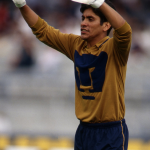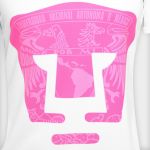
Love letters to Pumas' jersey
"la camiseta más bonita del mundo" and its football and graphic history
January 24th, 2019
"A puma with eyes of flint and a jaw of iron, which somehow contrives to look like the golden fist of some ancient Aztec demigod"
That was Guardian journalist John Ashdown attempt to describe Pumas logo, painting it with mystical references. Maybe too much – as he confessed that he was losing the run of himself there –, but the story that bonds with the realization of the logo it’s full of epic-mythological elements. During an interview that “El Pajarito” Manuel Andrade – the logo creator – gave to journalist Hector Huerta, he admitted in 1973 it took him more than three months and about one thousand attempts to realize the actual crest. A significant operation, almost maniacal, which result is a huge visual impact work, symmetric, geometrically accurate and graphically engaging. The strong contrast between the two traditional colors – azul y oro –, the essential design, the total absence of slogans and numbers are indeed the main elements determining the uniqueness of the logo itself, main feature of the kit too – "la más Bonita del Mundo", as reported by Fundación UNAM website, according to The Football Republic ranking about 2016/2017 football kits. Sober and stylized crest, but also particularly elaborate. Beyond the puma, there’s a hidden meaning: the eyes and the nose make an abstract figure that represents the "U" of the university, and the abstract figure connects to the mouth, which gives the impression of a cup, representing victory.

The Club Universidad Nacional was originally a college team, whose most common name – U.N.A.M. – is the acronym indicating the Universidad Nacional Autónoma de México, founder of club. The foundation dates back to 1954, in advance compared to the others two varsity clubs (Tigres Uanl, founded in 1960; Lobos de BUAP, whose first official match in Mexican football dates back to 1967), but perfectly on average compared to the others Mexican teams. If clubs like Pachuca, Cruz Azul, Toluca, Guadalajara e Atlante have been based in the early 1900s, most of the actual Liga MX teams were born after the Mexican Revolution. Villa and Zapata rebellion led to the promulgation of a new Constitution in 1917, ending Diaz dictatorial policy, which simultaneously held back Mexican football development.

It took them just eight years to play their first game in Primera Division. Seven national championships (‘76/’77, ‘80/’81, ‘90/’91, ‘03/’04, ‘04/’05, ‘08/’09, ‘10/’11), one Copa México, two Campeón de Campeones (the equivalent of Community Shield) and three CONCACAF Champions League: that’s the trophy case since promotion (1962). During the years, lots of players became real legends of the club, like Evanivaldo Castro Silva, better known as Cabinho, star of 1976 title, four times Liga MX leading scorer and all-time top scorer of the club (151 goals in 166 appearances). One of the most significant players in Pumas history are undoubtedly Hugo Sanchez (104 appearances and 97 goals between 1976 and 1981) “best CONCACAF player of the 20th century" (according to IFFHS) and Sergio Bernal, Pumas player with the biggest amount of appearances (519, between 1988 and 2010).
Besides the official name, U.N.A.M. has a nickname which has become a real identifier in the long term. In his motivational speeches for the university's American football team in the 1940s, coach Roberto 'Tapatio' Méndez would regularly compare his players to pumas (“inteligentes, rápidos, feroces y de carácter noble”) and the handle stuck. From 1942 every U.N.A.M. team adopted this nickname to refer to their players.
In occasion of the first official match of their history, Pumas took the field with a blue camiseta with a golden ‘V’ right in the center of the chest, very similar compared to traditional Velez and Brescia shirt. However, this format was abandoned in favor of a solid blue shirt, providing for the first time the logo: a golden ‘U’ obliquely cut by the Tricolor. In 1962, celebrating their first promotion ever, Pumas kit changed again (from solid to blue pinstripes on a golden background), ushering in a long list of cyclical transformations of the uniform.
In 1973 took place the breakthrough that led Puma shirt straight to a legendary dimension. The new logo created by Andrade quickly became emblematic representation and cutting edge of the club identity. The Puma was originally included in a triangle with rounded corners formed by three adjacent circles, representing the university's three fundamental tasks: teaching, culture, and sport. In 1974 the “puma” starts to be part of the shirt, first according to conventional standards, then – in 1975 – ignoring the traditional format and position almost covering the front of the shirt. Since then, Pumas uniform began to be subject of different experiments, always keeping the three main colors (light blue, white and gold) and the iconic position of the logo (except 2000/2001 season, in which Nike put it at the top center, as it was in 1974).

A long tradition of cyclical rotations and transformations, but not just that. The history of Pumas shirt is full of references to the past – the away shirt of this season is very similar compared to 1962 uniform; previous season kits were American football related because of the U.N.A.M. American football team 90th anniversary –, but also lots of elements linked to current events. During the Day of the Dead period, Pumas took the field with a holiday-related kit: same colors (blue and gold) but below the giant puma that stands on the shirt, there were two crossed bones, which clearly symbolized the Día de Los Muertos. Since 2011 the club released entire collections totally dedicated to female fans, supporting the fight against breast cancer.
At the beginning of 2019, U.N.A.M. presented the third kit, whose template reflects the same colors and the typical format, previously used for the 2017/2018 away kit (solid blue with golden puma in the middle). A low-budget option for Nike, which has however contributed to maintain a long tradition of stunning and worldwide unique kits.









































.png)


.jpg)

































